Wondering how much your 1934 Wheat penny is worth? You’re in the right spot.
In this quick guide, we’ll cover everything you need to know about this classic Lincoln cent. We’ll touch on its background and show how different factors—like condition, mint mark, and color—can impact its value.
Here’s a breakdown of the estimated market prices based on mint mark, grade, and color:
1934 No Mint Mark (Philadelphia)
- XF45
- Brown: $1
- MS60
- Brown: $5
- Red-Brown: $6
- Red: $8
- MS65
- Brown: $20
- Red-Brown: $28
- Red: $40
- MS67
- Red: $300
1934-D (Denver Mint)
- XF45
- Brown: $3
- MS60
- Brown: $9
- Red-Brown: $10
- Red: $18
- MS65
- Brown: $60
- Red-Brown: $70
- Red: $135
- MS67
- Red-Brown: $235
- Red: $3,250
History of the 1934 Wheat Penny
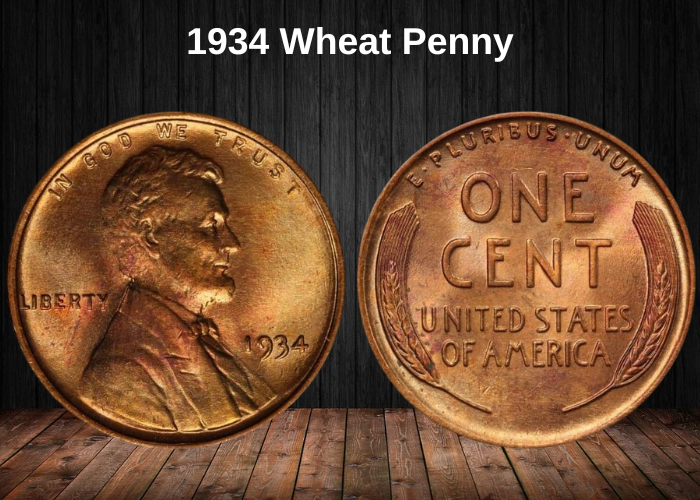
The 1934 Wheat Penny is one of the most well-known coins from the series of U.S. copper cents, which were minted from 1909 to 1958. In 1934, the U.S. economy was recovering from the Great Depression. Although there were no significant changes to the coin’s design that year, the Wheat Penny continued to feature the original design by Victor David Brenner, with Abraham Lincoln’s portrait on the obverse and wheat stalks flanking the date on the reverse. The production of the 1934 penny was substantial, but it doesn’t stand out for any specific historical events. However, it remains highly valued by collectors due to its age and historical significance.
Features of the 1934 Wheat Penny
The Obverse of the 1934 Penny
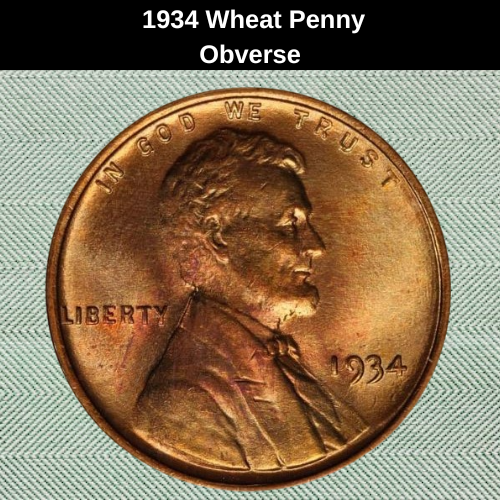
The obverse of the 1934 Wheat penny features the portrait of Abraham Lincoln, a design that will be familiar to anyone who has ever held a cent.
This image was created by Lithuanian artist Victor David Brenner. It depicts Lincoln in profile, facing to the right. Brenner later explained that he imagined the President as he would have looked while reading to a child.
At the base of the portrait are the artist’s initials, though they don’t appear on all Wheat pennies. The first coins had carried his initials on the reverse, but this led to an outcry, with some viewing the initials as “advertising”. Due to public backlash, coin production was halted, and with time pressing on, the Mint decided to remove the initials altogether.
Despite Brenner’s protests, the initials were removed, and the coin remained unsigned until 1918, when the initials were finally reinstated on the obverse, where they remain today.
Above the portrait, the words “IN GOD WE TRUST” curve along the upper edge of the coin. The word “LIBERTY” is inscribed to the left of the portrait, while the date appears a little further down and to the right.
A small “D” beneath the date indicates that the penny was struck in Denver. If there is no letter, it means the penny was minted in Philadelphia, the original Mint facility.
The Reverse of the 1934 Wheat Penny
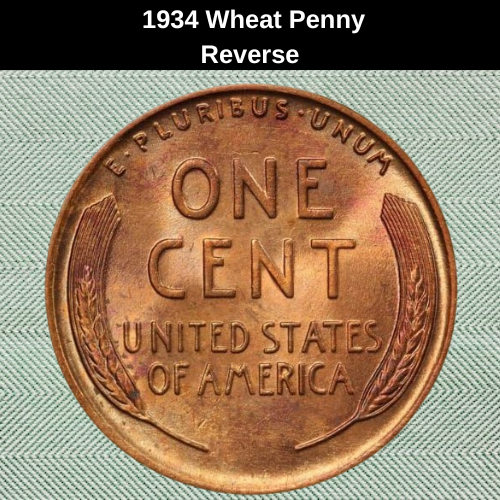
The reverse of the 1934 Wheat penny features a striking yet simple design. Two wheat stalks curve up on either side of the coin, forming a frame for the denomination and the country name.
The Latin phrase “E PLURIBUS UNUM” arches across the top of the coin, running parallel to the edge. The phrase translates to “From the many, one,” symbolizing the union of the states that formed the United States.
This design remained unchanged for 50 years, but it wasn’t Brenner’s first proposal. Initially, he had submitted a design featuring a tree branch. However, Mint officials deemed it too similar to French coins from the same period and sent Brenner back to revise the concept. The final wheat stalk design became the hallmark of the Wheat penny for decades.
Other Features of the 1934 Wheat Penny
The 1934 penny is made of bronze, a mixture of copper, tin, and zinc. Copper is the main component, which is why the color of individual coins can vary significantly.
This is because copper changes color depending on its exposure to the environment. A brand-new coin has a rich red color, but over time, as it is handled or exposed to air, it gradually turns brown due to the oxidation process.
In general, red coins are more collectible—and valuable—than their brown counterparts. Coin grading agencies use strict criteria to assess the color of a coin.
For a coin to be graded red, it must be red over at least 95 percent of its total surface area. If it’s brown over 95 percent, it’s considered a brown coin. Anything in between is categorized as “red and brown”.
If you’re interested in learning more about how to grade the color of Lincoln Wheat pennies, you can check out this informative YouTube video by Len Here.
1934 Penny Grading
Here’s a breakdown of the grading scale for a 1934 penny:
| # | Grade |
|---|---|
| 1 | Basal State-1 |
| 2 | Fair |
| 3 | Very Fair |
| 4, 5, 6 | Good |
| 7, 8, 10 | Very Good |
| 12, 15 | Fine |
| 20, 30 | Very Fine |
| 40 | Extremely Fine |
| 50 | About Uncirculated |
| 60 | Mint State |
| 65 | Mint State |
| 70 | Mint State |
To get an accurate idea of the value of your coin, it’s essential to understand where your penny falls on this scale. The higher the grade, the more valuable the coin typically is.
1934 Wheat Penny Value Guides
1934 No Mint Mark Wheat Penny Value
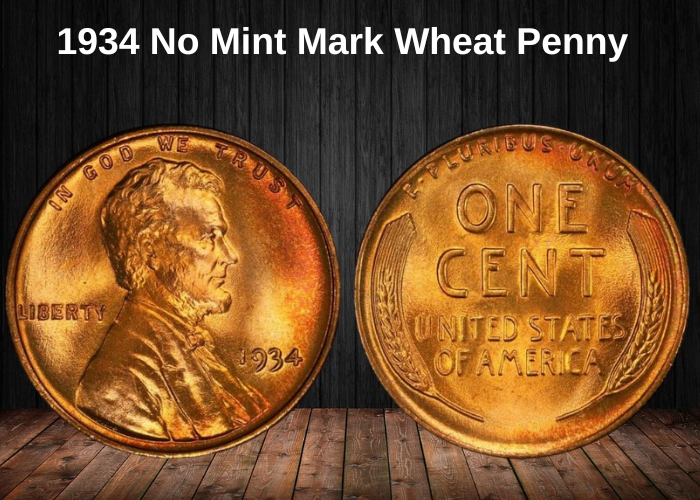
Pennies struck in Philadelphia do not have a mint mark beneath the date. This is because Philadelphia was the first Mint facility, and there was no need to distinguish its coins from those produced at other facilities.
While proof pennies were also struck in Philadelphia in other years, there were neither proof coins nor Special Mint Set coins in 1934. All 1934 pennies are business strikes, meaning they were produced for circulation. A total of more than 219 million of them were made.
The value of an individual penny will depend on three main factors:
- Color
- Condition
- Mint errors (which we’ll look at later)
Coin Condition and Grading:
Coin condition is graded on a scale from 1 to 70. Here’s what those grades mean:
- 1: Coins in the poorest condition where you can still identify the denomination and mintage.
- 70: Flawless coins, often referred to as “gem” coins.
Grading Scale:
- Circulated coins are graded from 1 to 59.
- Mint state coins are graded 60 and above, with 65+ indicating a “gem” coin.
Value Breakdown:
- Circulated brown 1934 no mint mark pennies (graded from 1 to 59) are generally worth face value unless they have a mint error.
- In “extremely fine” condition (graded XF40 to XF45+), a brown penny will be worth around $1.
- In “about uncirculated” condition (graded AU50 to AU58+), the value rises to about $3.
- A mint state brown coin starts around $10 and increases to $20 for gem coins (graded MS65 and above).
- The finest brown examples, graded MS66, are worth around $35.
Red and Brown Coins:
- Red and brown coins (graded from MS60 to MS67) range in value from $6 at the lower end (MS60) to $50 at MS66.
- A red and brown coin graded MS67 was certified by the PCGS, but there is no public sales history for these, although one certified by the NGC sold for $57 at auction in 2021.
Red Coins:
- The value of red 1934 pennies is higher and more variable, ranging from MS60 to MS68.
- At MS60, a red penny is valued at around $8.
- At MS65, the value rises to $40.
- Coins graded MS66+ or higher can reach three-figure prices.
- The highest grade, MS68, has been awarded to over 30 red coins, each valued at $5,500 by the PCGS.
Overall, a red 1934 penny in high grades is a significant investment, especially for coins graded MS66 or higher.
1934 D Wheat Penny Value
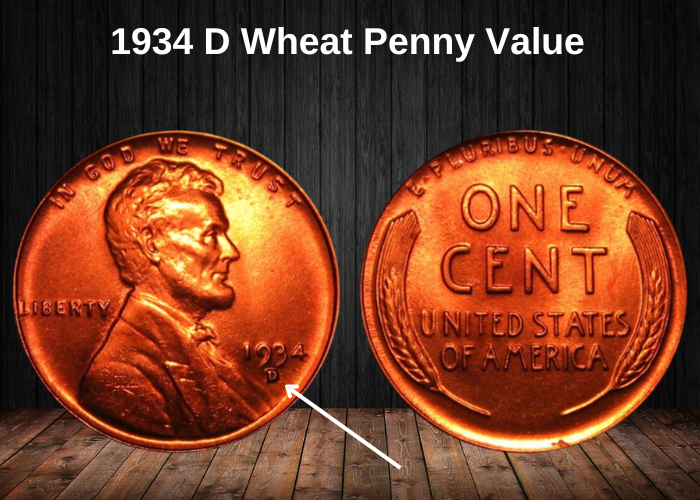
Fewer Wheat pennies were struck in Denver in 1934 compared to Philadelphia, with a mintage of 28.4 million coins.
Brown coins in circulated condition are still relatively easy to find, with an estimated 2.9 million surviving today. As a result, coins graded below 12 on the scale will likely be worth only face value. Brown coins in “about uncirculated” grades (AU50 to AU58+) are valued at around $8.
Value Breakdown for Denver (1934 D) Pennies:
- Mint State:
- MS60: Brown 1934 D penny is valued at around $9.
- MS63: $15.
- MS65: A gem coin is valued at $60.
- MS66: The finest brown coins certified by the PCGS are valued at $75.
- Red and Brown Coins (mostly uncirculated grades):
- MS60: Red and brown 1934 D coins are worth around $10.
- MS63: $20.
- MS65: $70.
- MS67: Only one red and brown coin has been graded at MS67, valued at $235.
Red Coins:
- Red 1934 D pennies are rarer and more valuable:
- MS60: Red coins are valued at $18.
- MS63: $35.
- MS65 (gem): $130 or more.
- The highest grade for 1934 D pennies is MS67+, and 20 coins have been certified at this level, with values reaching up to $6,350 each.
Overall, Denver-minted 1934 pennies in higher grades, especially red coins, are significantly more valuable than their brown counterparts.
Rare 1934 Wheat Penny Errors list
1934 (P) No Mint Mark Wheat Penny, Double Die Obverse
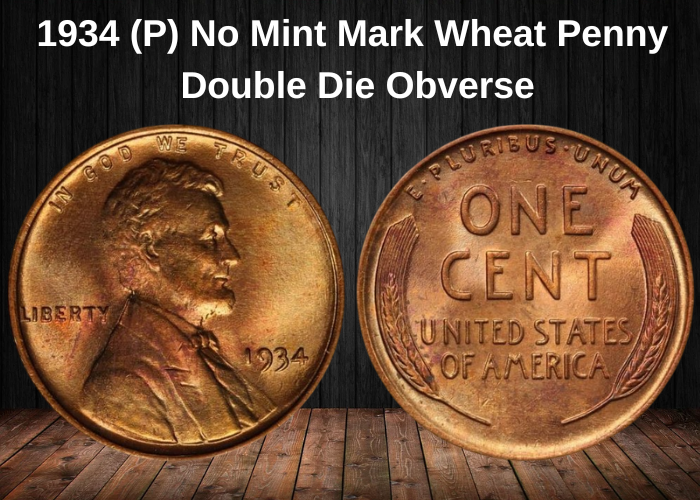
Among the 1934 Wheat pennies struck in Philadelphia, there are some that exhibit a double die obverse error. This error occurs during the die manufacturing process, where the die is struck multiple times to capture every detail of the obverse design in a process called “hubbing.” Any movement during this process causes double lines to appear on parts of the design, which are then transferred to the coins struck by that defective die.
Value of Double Die Obverse 1934 Pennies:
The value of a 1934 no mint mark Wheat penny with a double die obverse depends on its condition:
- Brown coin (graded 15): In 2014, one sold at auction for $248.
- Brown coin (graded MS66): A coin certified by the PCGS at MS66 is valued at $1,350.
For red and brown coins:
- MS60: A red and brown example is valued at around $600.
- MS65: The top grade for this color has two examples, each worth $1,350 — the same as a brown coin at MS66.
For red coins:
- The PCGS has certified one example each at MS65 and MS66.
- The MS65 example is worth $2,000.
- There is no public sales data or value estimate for the MS66 coin, making it even rarer and potentially more valuable.
Overall, double die obverse 1934 Wheat pennies with high grades, especially those with the red color, are quite valuable due to the rarity of this error.
1934 D Wheat Penny, Re-punched Mint Mark
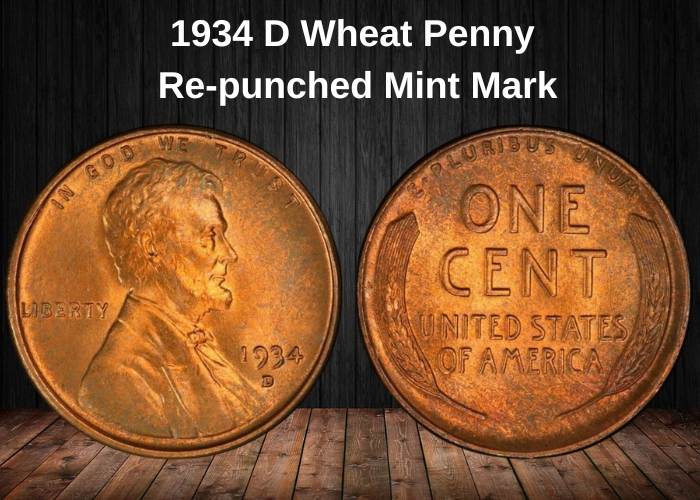
Some of the 1934 Wheat pennies struck in Denver feature a re-punched mint mark (RPM) — an error where the “D” mint mark was stamped more than once in slightly different positions. This kind of error usually requires a microscope or loupe to detect, as the second D can be faint or partially visible alongside the first.
Value of 1934-D RPM Pennies:
As with other coins, the value of a re-punched mint mark penny depends heavily on its condition and color:
- Brown, AU53: One sold at auction in 2014 for $164.
- Red and Brown, MS64: Sold in 2013 for $748.
- Red, MS67: A top-grade example sold for $3,745 in 2018.
These values highlight how dramatically rarity and condition can impact price — especially for collectors seeking the finest examples of mint errors.
Where to sell your penny?
Now that you know the value of your penny, you might be wondering where to sell it. Don’t worry: here’s a guide to some of the best online platforms where you can easily sell your coins, along with their advantages and disadvantages.
Discover the best platforms for selling coins online (pros and cons).
FAQs
1. What makes the 1934 Wheat Penny a transitional piece in U.S. coinage history?
** The 1934 Wheat Penny represents a recovery year following the worst of the Great Depression. Minting activity increased again after the historically low mintages of 1931 and the complete halt of penny production in 1932. The 1934 issue symbolizes a return to more regular coinage operations and a shift toward economic stabilization in the U.S.
2. How many mints produced the 1934 penny and how do the mint marks affect rarity and value?
The 1934 Wheat Penny was produced at two mints:
- Philadelphia (no mint mark) – over 219 million minted.
- Denver (D mint mark) – around 28 million minted.
While the Philadelphia issue is common, the 1934-D is less common, especially in higher grades. In mint state, particularly with full red luster (MS65 RD+), the 1934-D carries a higher premium and is more sought-after by collectors.
3. What are the most valuable grades and designations for 1934 Wheat Pennies?
Uncirculated 1934 and 1934-D pennies graded MS65 RD and above are especially valuable. Key designations collectors look for include:
- BN (Brown): Most common in circulated coins.
- RB (Red-Brown): Intermediate in value.
- RD (Red): Highest value due to fresh luster.
A 1934-D in MS66 RD can exceed $500 depending on eye appeal, while Philadelphia examples in MS67 RD may fetch $200–$300 or more.
4. Are there any known varieties or errors that collectors pursue from the 1934 issue?
Yes, although not widely recognized by major grading services, collectors have reported:
- Die cracks, particularly around Lincoln’s shoulder or the reverse lettering.
- Re-punched mint marks (RPMs) on 1934-D coins.
- Off-center strikes and lamination errors, which are relatively minor but collectible.
Any 1934-D RPM verified by third-party grading (like PCGS or NGC) can significantly increase the coin’s value.
5. What historical or economic factors influenced the minting volume of 1934 Wheat Pennies?
The increase in mintage during 1934 was influenced by Roosevelt’s New Deal, which began to revitalize the U.S. economy. More coins were needed as employment rose, trade increased, and consumer activity resumed, making 1934 one of the first post-crash years with a substantial rise in coin production.
6. What is the best strategy for collectors when acquiring 1934 Wheat Pennies?
Focus on:
- Certified high-grade specimens (MS64 or higher).
- Prioritize Red (RD) coins with strong luster and clean surfaces.
- Look for 1934-D RPM varieties, if authenticated.
- For set builders, aim for matched color and grade when collecting both P and D mint versions.
These strategies will help increase both the numismatic and investment value of your collection.
7. How does the 1934 Wheat Penny perform in terms of long-term investment value?
While not considered rare, the 1934-D in high grade has seen consistent value growth due to lower mintages and collector demand. Red Mint State examples are becoming harder to find untoned, and registry collectors often seek top-pop examples. As fewer high-end coins remain in the open market, values are likely to appreciate steadily, particularly for certified MS66+ RD coins.



















































